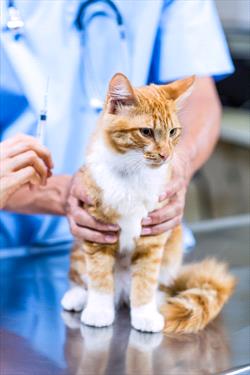Orange stripped cat on exam table .jpg

Feline infectious peritonitis (FIP) is a deadly infection in cats that is caused by the FIP virus. The disease occurs most commonly in young cats, although it can infect older cats too. It affects multiple organs, comes on very quickly, and very few infected cats survive.
How Contagious Is FIP?
FIP virus is actually a type of mutated feline coronavirus that infects a cat’s gastrointestinal (GI) tract. Before it mutates, this type of coronavirus is extremely common and highly contagious among cats. However, very few cats that become infected with this type of coronavirus get sick. The few that become sick only show mild signs of GI upset, such as diarrhea or loose stool. Many cats can harbor this type of coronavirus for years, shedding infectious viral particles in their stool and unknowingly infecting other cats.
FIP mostly occurs in cats that have already been infected with feline coronavirus. The feline coronavirus mutates into the FIP virus, which then begins to damage the cat’s organ systems. It is uncommon for this mutation to occur; many cats with coronavirus will never have their virus mutate into the FIP virus. It is also extremely rare for a cat with FIP to directly infect another cat with FIP because, unlike feline coronavirus, FIP virus particles are not easily shed and spread to other cats.
What Does FIP Infection Look Like?
FIP tends to occur in two forms, an effusive form in which fluid develops in areas of the body where it shouldn’t (e.g., the lungs, around the heart, in the belly), and a dry form, in which granular masses form throughout the body and damage internal organs. Sometimes one form will occur first, followed by the other. The effusive form is the most common.
Signs of FIP include tiredness, not wanting to play or move around, an enlarged belly, trouble breathing, poor appetite, weight loss, fever that may come and go, yellowing of the skin and eyes, poor vision or blindness, and neurological signs like seizures or wobbliness when walking. Not all signs will occur at once, nor will all signs be present in each infected cat.
How Is FIP Diagnosed?
Diagnosing FIP is difficult because although there are new tests available, veterinarians don’t have one specific test that can confirm FIP. Laboratory tests that scan for FIP virus are often positive in any cat that has feline coronavirus, whether it has mutated or not. Remember that feline coronavirus infection is very common in cats, and many aren’t affected by the infection.
A positive test doesn’t necessarily mean that FIP is the cause of a cat’s signs or symptoms. Your veterinarian will need to run multiple tests to get a big picture of whether the FIP virus is present, including analyzing blood samples for internal organ damage, examining samples of fluid obtained from the belly or chest, X-rays (radiographs), and ultrasound to look for fluid and organ damage, and testing for antibodies to FIP/coronavirus or viral particles.
Many cases of FIP are presumed based on the cat’s clinical signs or symptoms and the combined findings from the tests, but they are not officially diagnosed. In some cases, diagnosis can only be made after the cat has passed away by performing a necropsy, which is like a human autopsy, and biopsying samples of organ tissues.
How Is FIP Treated?
Unfortunately, no licensed, federally approved cure for FIP exists in the USA. Several types of treatments are being investigated that may be helpful for cats with FIP; however, these treatments remain under study and are not available in the USA. There are several types of treatments that have been studied, which act as antiviral drugs against the FIP virus and may be helpful for cats with FIP. They include a nucleoside analog called GS-441524 and an antiprotease inhibitor called GC376.
For the most part, treatment involves keeping the cat comfortable and reducing organ damage and inflammation. Such treatments may include nutritional support, removing fluid from the belly or chest when needed, and prednisolone or other types of steroids. These types of treatments are only meant to keep the cat comfortable. Fluid often rapidly returns once it has been removed, and steroids may not help with inflammation enough to buy an infected cat more time.
In some cases, euthanasia is a kinder option than prolonging a cat with FIP’s suffering. After clinical signs start, some cats with FIP will not live for more than a few days, although some can live for weeks. It is important to discuss a cat’s quality of life with a veterinarian to determine their level of suffering during the time that is left.
Can FIP Be Prevented?
Feline coronavirus mutation to FIP virus cannot be prevented, and it is unclear what causes the mutation. Preventing coronavirus from spreading among cats can be attempted, but this can be very difficult as it is extremely common. Possible ways to minimize coronavirus spread among cats include reducing stress, preventing/decreasing fecal contamination in the environment by cleaning litterboxes daily and keeping adequate numbers of litterboxes in multi-cat households, and testing and separating coronavirus-positive cats from coronavirus-negative cats. Even with these measures, coronavirus may still spread. A vaccine for coronavirus is also available, but it does not appear to fully prevent cats from getting coronavirus, nor does it prevent cats with coronavirus from developing FIP.
What Should I Do If My Cat Might Have FIP?
If you think your cat has started showing signs of FIP, make an appointment to see your veterinarian as soon as possible. Although FIP is usually fatal, other diseases can cause signs similar to FIP that are treatable. Further, seeing a veterinarian quickly when FIP is the cause of your cat’s signs can prevent unnecessary suffering.